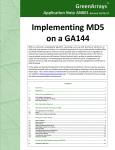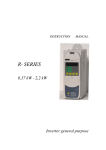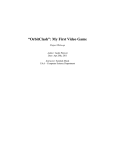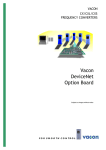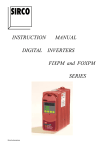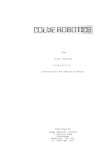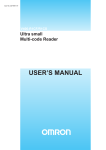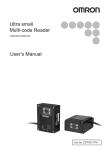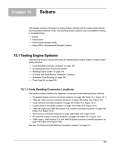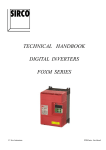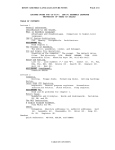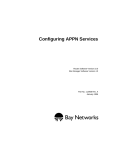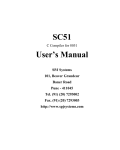Download (FLEX) Reference Manual (86 Pages PDF 115K)
Transcript
FC6809 INTROL-C
STANDARD LIBRARY
REFERENCE MANUAL
(FLEX)
The contents of this manual have been carefully reviewed and are
believed to be entirely correct. However, Introl Corp. assumes no
liability for inaccuracies.
The software described in this manual is proprietary and is
furnished under a license agreement from Introl Corp. The software
and supporting documentation may be used and/or copied only in
accordance with said license agreement.
INTROL-C is a registered trademark of Introl Corp.
FLEX and UniFlex are trademarks of Technical Systems Consultants, Inc.
OS9 is a trademark of Microware Systems Corp.
UNIX is a trademark of Bell Laboratories
Introl Corp.
647 W. Virginia St.
Milwaukee, WI 53204 USA
tel. (414) 276-2937
Copyright 1983 Introl Corp.
All Rights Reserved
FC6809 STANDARD LIBRARY
This manual describes each of the standard library
routines
supported by the FC6809 Introl-C Standard Library. The FC6809
Standard Library is usable with the Introl "fld' Loader for
producing programs that are compatible with, and executable under,
the Flex operating system. Note that Introl-C uses system call names
which may differ from those used by your operating system. Those
system calls which perform a function which is analogous to a
recognized UNIX system call have been given the corresponding UNIX
name rather than the name used by the particular operating system.
The library functions appear in alphabetical order in this-manual.
IMPORTANT NOTE: The majority of functions contained in the
Standard Library have been pre-assigned a module "class number"
of zero (0). Several "non-zero" class Standard Library modules
are
also included for user convenience, however, and are
identified in the Appendix at the end of this Standard Library
Manual. In general, these non-zero class modules are alternate
forms of identically named class zero modules that exist in the
library, modified to fit specific programming applications.
The following is a list of the functions included in this manual.
FUNCTION DESCRIPTION
abs
alloc
atof
atoi
atol
cprep
cstart
ecvt
execl
exit
_exit
_extend
fclose
fcvt
fgets
_filespec
_fms
fopen
fprintf
fputs
free
fscanf
getc
getchar
_getchr
gets
-
PAGE
integer absolute value
allocate memory
convert string to float
convert string to integer
convert string to long
prepare environment for C program
runtime preparation routine
float to string conversion
execute a program
exit a program with file cleanup
exit a program without file cleanup
extend float
close file
float to string conversion
read file into string
Build file specification
Call to FLEX FMS entry point
open a file
formatted output conversion
write a string to a file
free memory
formatted input conversion
get the next character from a file
get a character from the standard input
Call FLEX GETCHR entry point.
read input into string
0.1
1.1
2.1
3.1
4.1
5.1
6.1
7.1
8.1
9.1
10.1
11.1
12.1
13.1
14.1
15.1
16.1
17.1
18.1
19.1
20.1
21.1
22.1
23.1
24.1
25.1
26.1
index
isalpha
isdigit
islower
isspace
isupper
itoa
longjmp
malloc
max
min
modf
movmem
printf
putc
putchar
_putchr
puterr
puts
reverse
rewind
rindex
sbrk
scanf
_setext
setjmp
sprintf
sscanf
strcat
strcmp
strcpy
strlen
strncat
strncmp
strncpy
strsave
tolower
toupper
uldiv
ulmcd
ulmul
_unext
ungetc
ungetchar
unlink
-
find first occurrence of character
test for alpha character
test for digit
test for lower case
test for white space
test for upper case
convert integer to ascii string
non-local goto
allocate memory
return the maximum of two values
return the minimum of two values
return fractional part of float
copy a block of memory from one-location to another
formatted output conversion
write a character to a file
write a character to the standard output
Call FLEX PUTCHR entry point.
write a char to the standard error output (STDERR)
write a string to standard output
reverse a string in place
reset specified file to beginning
find last occurrence of character
allocate memory
formatted input conversion
Call FLEX SETEXT entry point
non-local goto
formatted output conversion
formatted string conversion
copy string
compare strings lexicographically
copy string
return string length
copy string
compare strings lexicographically
copy string
save string in memory
convert to lower case
convert to upper case
unsigned long integer divide
unsigned long modulo operation
unsigned long multiply
unextend float
push character back on input stream
push character back on standard input stream
delete file
0.2
27.1
28.1
29.1
30.1
31.1
32.1
33.1
34.1
35.1
36.1
37.1
38.1
39.1
40.1
41.1
42.1
43.1
44.1
45.1
46.1
47.1
48.1
49.1
50.1
51.1
52.1
53.1
54.1
55.1
56.1
57.1
58.1
59.1
60.1
61.1
62.1
63.1
64.1
65.1
66.1
67.1
68.1
69.1
70.1
71.1
NAME
abs - integer absolute value
SYNOPSIS
int
int
abs(i)
i;
DESCRIPTION
abs returns the absolute value of its integer operand.
DIAGNOSTICS
SEE ALSO
NOTES
1.1
NAME
alloc - allocate memory
SYNOPSIS
char
int
*alloc(size)
size;
DESCRIPTION
alloc will attempt to allocate a block of memory whose size is
given by the argument. If it is successful it returns a pointer
to that memory otherwise it returns NULL.
DIAGNOSTICS
Returns NULL if the memory could not be allocated.
SEE ALSO
free(), sbrk()
NOTES
Alloc is an obsolete
malloc() and returns.
name
for
malloc().
2.1
It
simply
calls
NAME
atof - convert string to float
SYNOPSIS
float
char
atof(cptr)
*cptr;
DESCRIPTION
The atof function converts a string into a float which is then
used as the return value of the function. The string should be
null terminated although atof will stop reading the string as
soon as an illegal character is reached. After ignoring
preceding blanks the atof routine will convert as much of the
string as conforms to normal floating point constant format to
a floating point number. It will stop at the first character
which is inconsistent with that format. If no floating point
constant is found a 0 is returned.
A floating point constant consists of an integer part, a
decimal point, a fractional part, and an exponential part. The
integer and fractional parts may each consist of a string of
one or more digits. The exponential part consists of an 'e' or
'E', followed by an optionally signed integer exponent. Either
the integer or the fractional part (but not both) may be
missing; either the decimal point or the exponential part (but
not both) may be missing.
DIAGNOSTICS
SEE ALSO
atoi(), atol()
NOTES
Presently it is permitted to have spaces between the 'e' or 'E'
and the first character of the integer representing the
exponent.
3.1
NAME
atoi - convert string to integer
SYNOPSIS
int
char
atoi(ptr)
*ptr;
DESCRIPTION
Atoi's argument is a pointer to char which is assumed to point
to a null terminated string which
contains
the
ASCII
representation of some integer number. The atoi function
converts a string into an int which is the return value. The
string should be null terminated although atoi will stop
reading the string as soon as an illegal character is reached.
After ignoring preceding blanks the atoi routine will convert
as much of the string as conforms to normal integer constant
format to an integer number. It will stop at the first
character which is inconsistent with that format. If no integer
constant is found a 0 is returned.
The integer constant format consists of an optional sign,
followed by one or more digits. There should be no spaces
interspersed within the number.
DIAGNOSTICS
SEE ALSO
atof(), atol()
NOTES
4.1
NAME
atol - convert string to long,
SYNOPSIS
long
char
atol(cptr)
*cptr;
DESCRIPTION
The atol function converts a string into a long which is the
return value. The string should be null terminated although
atol will stop reading the string as soon as an illegal
character is reached. After ignoring preceding blanks the atol
routine will convert as much of the string as conforms to
normal long integer constant format to a long integer. It will
stop at the first character which is inconsistent with that
format. If no long integer constant is found a 0 is returned.
The long integer constant format consists of an optional sign,
followed by one or more digits. There should be no spaces
interspersed within the number.
DIAGNOSTICS
SEE ALSO
atof(), atoi()
NOTES
5.1
NAME
cprep - prepare environment for C program
SYNOPSIS
int
int
char
char
cprep(argc,argv,eext)
argc;
**argv;
*eext;
DESCRIPTION
Cprep first prepares the environment for the user C program and
then call s "main", the usual entry-point to a user program.
Cprep is usually referenced only from "cstart". The user
program is not expected to make any explicit reference to this
routine.
DIAGNOSTICS
SEE ALSO
cstart
NOTES
The result of an explicit reference to cprep is undefined.
6.1
NAME
cstart - runtime preparation routine
SYNOPSIS
DESCRIPTION
Cstart is a runtime preparation routine which is normally the
first routine executed by an Introl-C program. Its only
function is to set up the environment enough to allow the
function "cprep" to be called. Cprep is a function which
produces the runtime environment which is-expected by the user
program. Cstart is included automatically by the linker. It is
NOT expected that a user program will reference
cstart
explicitly via a function call.
DIAGNOSTICS
SEE ALSO
cprep()
NOTES
The result of an explicit reference to cstart is undefined.
7.1
NAME
ecvt - float to string conversion
SYNOPSIS
char
float
int
int
*ecvt(arg,ndigits,decpt,sign)
arg;
ndigits;
*decpt,*sign;
DESCRIPTION
This is a formatting routine used by printf for formatting
floating point numbers in the e format.
Ecvt returns a pointer to a string which contains ascii
characters representing a floating point number. The first
argument is converted to a string whose length is indicated by
the second argument. The third argument points to a variable in
which the routine will write the location of the decimal point
relative to the start of the string (negative numbers indicate
that the decimal point is to the left of the first character of
the string). The variable pointed to by the fourth argument is
set nonzero if the float is negative otherwise it is set to
zero.
The string is written in a static data area local to ecvt and
is overwritten with the next call.
If the argument passed to ecvt is a legal floating point number
the string will consist of a series of ascii digits terminated
by a null. If the argument is out of the legal range for floats
(as per the IEEE standard) the string will contain "NaN" (Not a
Number). If the argument is either greater than the maximum or
less than the minimum allowed for a float the characters "inf"
(infinity) will be placed in the string (the fourth argument is
set to indicate positive or negative infinity). The string
itself contains neither a minus sign nor a decimal point nor a
base ten exponent.
DIAGNOSTICS
SEE ALSO
fcvt(), itoa()
NOTES
8.1
NAME
execl - execute a program
SYNOPSIS
int
char
execl(cmd,arg0,arg1,...,0)
cmd,*arg0,*arg1,.....;
DESCRIPTION
Execl causes the present program to cease execution and a new
program to execute. The name of the file to be executed must be
contained in a string pointed to by the first argument. The
additional arguments are assumed to be pointers to null
terminated strings.
These pointers will be passed to the
program to be executed if they appeared as parameters on a
command call line. The last argument MUST be a zero. The new
process is given the arguments which follow the first argument
in the execl call. The second argument of the execl call is the
FIRST argument passed to the program to be executed (by
convention referred to as argv(0). The last argument in the
execl call must always be a zero.
DIAGNOSTICS
This function NEVER returns.
SEE ALSO
NOTES
The sum total of lengths of the argument strings (including a
space to be placed between each argument) must not exceed the
length of a FLEX line buffer, which is 128 bytes long.
9.1
NAME
exit - exit a program with file cleanup
SYNOPSIS
int
int
exit(stat)
stat;
DESCRIPTION
Exit aborts a C program and returns to the operating system.
The status value is returned to the operating system. Exit also
flushes any open file buffers and closes all open files before
exiting.
DIAGNOSTICS
SEE ALSO
_exit()
NOTES
10.1
NAME
_exit - exit a program without file cleanup
SYNOPSIS
int
int
_exit(stat)
stat;
DESCRIPTION
_exit aborts a C program and returns to the operating system.
The status value is returned to the operating system. The _exit
routine does not explicitly flush the file buffers.
DIAGNOSTICS
SEE ALSO
exit()
NOTES
11.1
NAME
_extend - extend float
SYNOPSIS
int
float
struct
_extend(f,ef)
f;
extflt
{
char
sign;
int
exp;
long
mantissa
} *ef;
DESCRIPTION
_extend extends a floating point number (its first argument)
and stores the result in the structure pointed to by the second
argument. The first element of the structure contains the sign
bit of the number, the second element contains the unbiased
exponent, and the thirs element contains the mantissa.
DIAGNOSTICS
SEE ALSO
_unext()
NOTES
12.1
NAME
fclose - close file
SYNOPSIS
#include "stdio.h"
int
fclose(fp)
FILE
*fp;
DESCRIPTION
Fclose will close the file indicated by its argument. The
argument must be a file pointer which was previously returned
from an fopen unless it is STDIN, STDOUT, or STDERR. If the
file has been opened for writing, fclose will automatically
flush the remaining contents of the buffer.
DIAGNOSTICS
fclose will return ERROR if the file could not be closed. The
external variable "errno" will contain the error code which was
returned by the operating system..
SEE ALSO
fgets(), fopen(), fprintf(), fputs(), fscanf(), getc()
NOTES
13.1
NAME
fcvt - float
SYNOPSIS
char
float
int
int
to string conversion
*fcvt(arg,ndigits,decpt,sign)
arg;
ndigits;
*decpt,*sign;
DESCRIPTION
This is a formatting routine used by printf for formatting
floating point numbers in the f format. It is similar to the
"ecvt" routine except that the correct digit will be rounded as
demanded by Fortran F-format for the number of digits indicated
by the second argument
Fcvt
returns a pointer to a string which contains ascii
characters representing a floating point number.
The first
argument is converted to a string whose length is indicated by
the second argument. The third argument points to a variable in
which the routine will write the location of the decimal point
relative to the start of the string (negative numbers indicate
that the decimal point is to the left of the first character of
the string). The variable pointed to by the fourth argument is
set nonzero if the float is negative; otherwise it is set to
zero.
The string is written in a static data area local to fcvt and
is overwritten with the next call.
If the argument passed to fcvt is a legal floating point number
the string will consist of a series of ascii digits terminated
by a null. If the argument is out of the legal range for floats
(as per the IEEE standard) the string will contain "NaN' (Not a
Number). If the argument is either greater than the maximum or
less than the minimum allowed for a float the characters "inf"
(infinity) will be placed in the string (the fourth argument is
set to indicate positive or negative infinity).
The string
itself contains neither a minus sign nor a decimal point nor a
base ten exponent.
DIAGNOSTICS
SEE ALSO
ecvt(), itoa()
NOTES
14.1
NAME
fgets - read file into string
SYNOPSIS
#include "stdio.h"
int
fgets (s,n,fp)
char
*S;
int
n;
FILE
*fp;
DESCRIPTION
Fgets will read a line of up to n characters from the file
pointed to by its third argument into the area pointed to by
its first argument. Its third argument must be a file pointer
previously returned by an fopen call. Fgets returns a pointer
to the start of the line read or NULL if for some reason no
line could be read. The function reads the number of characters
indicated by its second argument or until an end of line is
encountered, whichever comes first. The trailing newline IS
included in the line read.
DIAGNOSTICS
fgets will return NULL if the file could not be read from; this
is usually interpreted as an End Of File.
SEE ALSO
fclose(), fflush(),
getc(), gets()
fopen(),
fprintf(),
fputs(),
fscanf(),
NOTES
If there is a trailing newline character read from the file
fgets will include it in the string whereas gets will not.
15.1
NAME
_filespec - Build file specification
SYNOPSIS
*include "stdio.h"
int
_filespec(n,fp,ext)
char
*n;
FILE
*fp;
char
ext;
DESCRIPTION
The
_filespec function builds a file specification in the fcp
pointed to by the second argument. The first argument points to
a file name string that may contain a drive specifier and an
extension. If no drive is given in the name, the system working
disk is assumed.
If no extension is given in the name, the
value of the third argument is used in a call to the FLEX
routine SETEXT to set the default extension. (see "The FLEX
Advanced Programmers Guide" for more details on the ext
parameter.)
DIAGNOSTICS
Returns ERROR if a valid file specification could not be made.
SEE ALSO
NOTES
This routine is used internally by some of the file routines
and is not guaranteed to be supported in the future.
16.1
NAME
_fms -
Call to FLEX FMS entry point
SYNOPSIS
#include "stdio.h"
int
_fms(fp,c)
FILE
*fp;
char
C;
DESCRIPTION
This is a short assembly language routine that allows a C
program to call the FLEX FMS entry point. The desired function
should be placed in fp->f.function (see the flex.h header
file).
The value of the second parameter is placed in the A
accumulator before the call to the FMS entry point. On return,
fms returns an integer representing the value of the A
Accumulator or ERROR.
DIAGNOSTICS
Returns ERROR if FLEX detected an error in the FMS call.
SEE ALSO
NOTES
This routine is used internally by some of the file routines
and is not guaranteed to be supported in the future.
17.1
NAME
fopen - open a file
SYNOPSIS
#include
"stdio.h"
FILE
*fopen(name,mode)
char
*name,*mode
DESCRIPTION
Fopen will open the file whose name is pointed to by its first
argument with the attributes indicated in the string pointed to
by its second argument. It returns a value of type pointer to
FILE which must be used as an argument on subsequent references
to the file.
The options with which the file is to be opened are specified
as ASCII characters in the mode string (whose pointer is passed
as the second parameter). One of the characters in this string
indicates the mode for which the file will be opened. The
appropriate modes are:
r - read: File is opened for read access
w - write: File is opened for write access
If neither of these characters appears in the string the file
is opened for read access. The result of placing more than one
of these characters in the string is undefined.
In addition to one of the preceding characters a b may appear
in the string.
The 'b' option indicates that the file is a
binary file while the absence of a 'b' indicates that the file
should be opened as a text file.
DIAGNOSTICS
Fopen will return ERROR if the file could not be opened and the
external variable "errno" will contain any error code returned
by the system.
SEE ALSO
fclose(),
fgets(),
fprintf(),
fputs(),
fscanf(),
getc()
NOTES
The current version of fopen returns ERROR when it fails to
open a file rather than the more common return value of NULL.
18.1
NAME
fprintf - formatted output conversion
SYNOPSIS
#include
"stdio.h"
int
fprintf(stream,control [,arg])
FILE
*stream;
char
*control;
DESCRIPTION
Fprintf is nearly identical to printf except that here the
output file specification is explicitly given as the first
argument.
All output is sent to the file pointed to by the
first argument. The parameters to fprintf consist of pointer
to FILE, followed by a pointer to a null terminated string,
followed by zero or more arguments. fprintf formats and writes
the arguments following the control string using the control
string to direct formatting and conversion. The control string
may contain normal characters (which are simply copied to the
output file) and conversion specifications which control the
writing of the arguments. Each conversion provides information
used to format its corresponding argument following the control
string.
Conversion specifications
begin with
a percent
character (%), perhaps followed by some options and terminated
by a conversion character. All the options are, of course,
optional but those that are included must appear in the
specified order.
The legal options (in the order they must
appear) are as follows:
Dash (-): indicates that if the number to be written is shorter
than the specified field length that it should be left
justified.
If this option is omitted the number will be
right justified.
Zero (0): indicates that if the number to be written is shorter
than the specified field length that it should be padded
with zeros to fill the field length. If this option is
omitted the field will be padded with blanks.
Digit string: indicates the minimum field width. The argument
will be written in a field at least this wide. This field
may be replaced with a star (*) which will cause the field
width to be taken from the next corresponding argument (of
type integer) in the argument list.
Period (.):
string.
separates the
field
Digit
width from
the
next digit
string: indicates the precision.
For a float the
precision
is the number of digits to be written to the
right of the decimal point. For a string the precision is
the maximum number of characters which will be written.
This field may be replaced with a star (*) which will
cause
the field width to be taken from
the next
19.1
corresponding
argument list
Long
argument (assumed
to be an
integer) in the
(l): (letter ell) indicates that the corresponding
argument is to be written as a long rather than an int.
The valid
follows:
conversion
characters and
their
meanings
are as
d
The argument is assumed to be of
in decimal notation.
o
The argument is written in octal (without leading 0).
x
Argument is written in hexadecimal (without leading Ox).
u
The argument is assumed
decimal notation.
c
The argument is written as a character.
s
The argument is assumed to be a pointer to a null
terminated string. Characters are copied from the control
string to the output string until a null character is
reached or until the number of characters given by the
precision are copied. The terminating null is not copied.
e
The argument is assumed to be a float and written out in a
decimal
notation
of
the
following
form:
[-d.dddddde[+|-]dd That is a negative sign if the number
is negative, a single digit, followed by a decimal point,
followed by several digits, followed by an 'e', followed
by a sign, followed by two digits.
f
The argument is assumed to be a float and written out in a
decimal notation of the following form: [-]ddd.dddd where
the length of the string of digits following the decimal
point is given by the precision.
g
Prints in either e or f format; whichever is shorter.
to be
type int and is written
unsigned and
written in
If
a character which is
neither an option nor a conversion
character is found while scanning a conversion specification
the character following the percent sign (%) is simoly written
and no conversion specification is assumed.
Thus to write a
percent sign one writes it twice(%%).
DIAGNOSTICS
Fprintf returns ERROR if it fails.
SEE ALSO
printf(),sprintf()
19.2
NAME
fputs - write a string to a file
SYNOPSIS
#include "stdio.h"
int
fputs(s,fp)
char
*S;
FILE
*fp;
DESCRIPTION
Fputs copies the string pointed to by the first argument to the
file indicated by the second
argument. The second argument
of type pointer to FILE and should have been returned by a call
to fopen unless it is STDOUT or STDERR.
DIAGNOSTICS
Returns ERROR
the string.
if an error occurred
SEE also
puts()
NOTES
20.1
while attempting to write
NAME
free - free memory
SYNOPSIS
char
char
*free(block)
*block;
DESCRIPTION
Free will attempt to free a block of memory indicated by its
argument.
The only valid argument for free is a pointer
previously returned by an alloc call. This routine should only
be used to free a block that has been allocated via alloc. The
result of freeing the same block of memory more than once or
attempting to use, as an argument, a pointer which was not
returned by an alloc call is undefined (bad things happen).
DIAGNOSTICS
SEE ALSO
alloc(), sbrk()
NOTES
21.1
NAME
fscanf - formatted input conversion
SYNOPSIS
#include
"stdio.h"
int
fscanf(file,control [,pointer1]...)
FILE
*file;
char
*control;
DESCRIPTION
Fscanf is nearly identical to scanf except that the input file
specification is explicitly stated; the input is taken from the
file pointed to by the first argument. The parameters to fscanf
consist of a pointer to file, followed by a pointer to a null
terminated string (the control string), followed by zero or
more
arguments of type pointer. Fscanf reads groups of
characters from the input file pointed to by the first
argument, interprets them according to the control string, and
writes the results into the arguments pointed to by their
corresponding argument pointers. The control string may contain
blanks, tabs, and newlines which match optional white space in
the input; it may contain ordinary characters which must match
the input string exactly character per character; and it may
contain
conversion
specifications used to control the
interpretation
of
the input
stream.
Each
conversion
specification provides information used to translate a segment
of the input stream into a value which may then be placed into
an argument pointed to by its corresponding pointer in the
argument list.
Conversion
specifications begin with a percent character
perhaps
followed
by some options, and terminated by a
conversion character. All the options are, of course, optional
but those that are included must appear in the specified order.
The legal options (in the order they must appear) are:
Star
(*): indicates that this conversion specification has no
corresponding pointer in the
argument
list.
This
effectively skips a value in the input stream.
Digit
string: indicates the maximum field width; the maximum
number of characters which this conversion specification
will cause to be read from the input stream.
Long (l): (letter ell) indicates that the corresponding pointer
is pointing to a long rather than an int.
This has no
effect when preceding an e or f.
The valid
follows:
d
conversion
characters and
their
meanings
are as
A decimal integer is expected in the input string.
corresponding pointer is assumed to be of type *int.
22.1
Its
o
An octal integer is expected in the input string. Its
corresponding pointer is assumed to be of type *int.
x
A hexadecimal integer is expected in the input string. Its
corresponding pointer is assumed to be of type lint.
h
A decimal integer is expected in the input string.
corresponding pointer is assumed to be of type short.
u
An unsigned
decimal integer is
expected in the input
string. Its corresponding pointer is assumed to be of type
*unsigned.
c
The very next character is read from the input string
(even if it's a blank).
Its corresponding pointer is
assumed to be of type char.
s
A
string
is
expected
in
the input string. Its
corresponding pointer is assumed to be of type *char. It
should point to a space large enough to hold the input
string plus an added null.
Characters are read, starting
with the next nonblank character, until the number of
characters given in the precision is reached or until a
blank, tab, or newline is reached.
e
(same as f)
f
A floating point number is expected in the input string.
Its corresponding pointer is assumed to be of type *float.
Its
DIAGNOSTICS
The return value of this function is the number of parameters
that were matched (read in from the input line) or EOF (-1).
SEE ALSO
scanf(), sscanf()
NOTES
Exactly one line of input is consumed for each call to fscanf.
Thus fscanf will not fetch a new line even though there are
still conversion specifications left to process nor will it
save any input left from the preceding line for the next call
to fscanf.
A hexadecimal number may not be preceded by a 0x.
Any character within a conversion specifier which is not a
legal conversion specifier option or conversion character will
be ignored along with the preceding percent sign and any
characters inbetween. Thus there is no way to match a '%' on
the input line.
22.2
NAME
getc - get the next character from a file
SYNOPSIS
#include "stdio.h"
int
getc(fp)
FILE
fp;
DESCRIPTION
Getc returns the next character from the file indicated by its
argument.
Its argument is of type pointer to FILE and should
have been previously returned from an fopen call unless it is
STDIN.
DIAGNOSTICS
Getc returns ECF (-1) upon reading end of file or on error.
SEE ALSO
getchar()
NOTES
Notice the return value of getc is an integer not a character.
This is so that getc can return ECF (-1) on end of file.
23.1
NAME
getchar - get a character from the standard input
SYNOPSIS
int
getchar()
DESCRIPTION
Getchar is identical to getc(stdin).
character from the standard input.
It
returns
the next
DIAGNOSTICS
Getchar returns ECF (-1) upon reading end of file or on error.
SEE ALSO
getc()
NOTES
Notice the return value of getchar is an integer not a
character.
This is so that getchar can return an ECF (-1) on
end of file.
24.1
NAME
_getchr - Call FLEX GETCHR entry point.
SYNOPSIS
#include "stdio.h"
int
_getchr()
DESCRIPTION
This function returns the value obtained by a call to the FLEX
entry point GETCHR (get console character).
DIAGNOSTICS
SEE ALSO
NOTES
This routine is used internally by some of the file routines
and is not guaranteed to be supported in the future.
25.1
NAME
gets - read input into string
SYNOPSIS
int
char
gets(s)
*S;
DESCRIPTION
Gets will read a line from the standard input (STDIN) into
the area pointed to by its argument.
Gets returns a pointer
to the start of the line read, or NULL if for some reason no
line could be read.
The function reads until an end of line
is encountered. The trailing newline is NOT included in the
line read (compare this with fgets(s,n,stdin)).
DIAGNOSTICS
Gets will return NULL on end of file and error.,
SEE ALSO
Fclose(),
fflush(),
fscanf(), getc().
fgets(),
fopen(),
fprintf(),
fputs(),
NOTES
Gets will not include any
string whereas fgets will.
trailing newline
26.1
character in the
NAME
index - find first occurrence of character
SYNOPSIS
int
index(s,c)
char
*s;
char c;
DESCRIPTION
Index searches the string whose pointer is passed as its first
argument and returns a pointer to the first occurrence of the
character specified by the second argument. A zero is returned
if the character does not appear in the string.
DIAGNOSTICS
SEE ALSO
rindex()
NOTES
27.1
NAME
isalpha - test for alpha character
SYNOPSIS
int
char
isalpha(ch)
ch;
DESCRIPTION
Returns true (non zero) if its argument is an alpha character
(a through z or A through Z); otherwise returns false (zero).
DIAGNOSTICS
SEE ALSO
isdigit(),
islower(), isspace(), isupper()
NOTES
28.1
NAME
isdigit - test for digit
SYNOPSIS
int
char
isdigit(ch)
ch;
DESCRIPTION
Returns true (non zero) if its argument is a digit (0 through
9); otherwise returns false (zero).
DIAGNOSTICS
SEE ALSO
isalpha(), islower(), isspace(), isupper()
NOTES
29.1
NAME
islower - test for lower case
SYNOPSIS
int
char
islower(ch)
ch;
DESCRIPTION
Returns true (non zero) if its argument is a lower case alpha
character (a through z); otherwise returns false (zero).
DIAGNOSTICS
SEE ALSO
isalpha(), isdigit(), isspace(), isupper()
NOTES
30.1
NAME
isspace - test for white space
SYNOPSIS
int
char
isspace(ch)
ch;
DESCRIPTION
Returns true (non zero) if its argument is a space, tab, or
newline character; otherwise returns false (zero).
DIAGNOSTICS
SEE ALSO
isalpha(), isdigit(), islower(), isupper()
NOTES
31.1
NAME
isupper - test for upper case
SYNOPSIS
int
char
isupper(ch)
ch;
DESCRIPTION
Returns true (non zero) if its argument is an upper case alpha
character (A through Z); otherwise returns false (zero).
DIAGNOSTICS
SEE ALSO
isalpha(), isdigit(), islower(), isspace()
NOTES
32.1
NAME
itoa SYNOPSIS
int
int
char
convert integer
to ascii string
itoa(n,s)
n;
*S;
DESCRIPTION
Itoa converts its first argument into a null terminated ascii
string which is stored at the location pointed to by its second
argument.
If the integer is negative the string will be
preceded by a minus sign. The second argument should point to
an area large enough to contain the resultant string which may
contain a sign, up to 5 digits, and a NULL termination
character.
DIAGNOSTICS
SEE ALSO
fcvt(), ecvt()
NOTES
33.1
NAME
longjmp - non-local goto
SYNOPSIS
#include
"stdio.h"
int
longjmp(envp,n)
struct jmp_buf *envp;
int
n;
DESCRIPTION
Longjmp works in conjunction with setjmp to provide the ability
to jump outside of a function. Compare this to a normal goto
for which the destination must be in the same function as the
goto statement.
Setjmp is used to mark a location as a
destination (that is save a copy of the current environment)
for later use by the longjmp routine. The argument to setjmp is
a pointer to structure which will hold the current environment.
A pointer to this structure is used as an argument to longjmp.
Longjmp simply restores the environment which was saved by the
setjmp call. The effect is that execution continues at the
location where the environment was saved (inside the setjmp
call). The appearance is that of a return from setjmp.
To mark a location one makes a call to setjmp.
This will
initialize the contents of the structure whose pointer was
passed as an argument. From this call, setjmp will return the
value 0. Later, when control is returned here from a longjmp,
the return value will be decided by the second argument of the
longjmp call.
Now a jump can be made to this location by making a call to
longjmp, using a pointer to the same structure that was
initialized by setjmp as the first argument and an integer as
the second argument. The second argument, will be used as the
return value when control is transferred
to the setjmp
environment
The destination of a longjump must be in a function which has
not itself returned inbetween the call to setjmp and the call
to longjmp.
That is, the destination of a longjmp must be
within a currently active function.
DIAGNOSTICS
SEE ALSO
NOTES
34.1
NAME
malloc
SYNOPSIS
char
int
allocate memory
*malloc(size)
size;
DESCRIPTION
malloc will attempt to allocate a block of memory whose size is
given by the argument. If it is successful it returns a pointer
to that memory, otherwise it returns NULL.
DIAGNOSTICS
Returns NULL if the memory could not be allocated.
SEE ALSO
free(), sbrk()
NOTES
35.1
NAME
max - return the maximum of two values
SYNOPSIS
int
int
max(a,b)
a,b;
DESCRIPTION
Max returns the greater of its two arguments.
DIAGNOSTICS
SEE ALSO
min()
NOTES
36.1
NAME
min - return the minimum of two values
SYNOPSIS
int
int
min(a,b)
a,b;
DESCRIPTION
Min returns the lesser of its two arguments.
DIAGNOSTICS
SEE ALSO
max()
NOTES
37.1
NAME
modf - return fractional part of float
SYNOPSIS
float
float
float
modf(fp,fint)
fp;
*fint;
DESCRIPTION
Modf takes a floating point number as its first argument and
returns its fractional part. Its nonfractional part is written
to the location pointed to by the second argument.
This routine is used by ecvt and fcvt.
DIAGNCSTICS
SEE ALSO
NOTES
38.1
NAME
movmem
- copy a block of
memory from one location to another
SYNOPSIS
int
movmem (from,to,length)
char
*from, *to;
unsigned
length;
DESCRIPTION
Movmem copies the number of bytes given by the third argument
from the location pointed to by first argument to the location
pointed to by the second argument. The new copy will exactly
reflect the original as it existed before the call even if the
two blocks of memory overlap (in that case, of course, the
original will be partially overwritten).
DIAGNOSTICS
SEE ALSO
NOTES
39.1
NAME
printf - formatted output conversion
SYNOPSIS
int
char
printf(control [,arg]...)
*control;
DESCRIPTION
Printf is nearly identical to fprintf excect that there is no
output file specification explicitly stated; the result is
written to stdout.
The parameters to printf consist of a
pointer to a null terminated string followed by zero or more
arguments.
Printf formats and writes the arguments following
the
control string using the
control string to direct
formatting and conversion.
The control string may contain
normal characters (which are simply copied to the output file)
and conversion specifications which control the writing of the
arguments.
Each conversion specification provides information
used to format its corresponding argument following the control
string.
Conversion specifications begin with a percent
character (%), perhaps followed by some options and terminated
by a conversion character. All the options are, of course,
optional but those that are included must appear in the
specified order.
The legal options (in the order they must
appear) are as follows:
Dash (-): indicates that if the number to be written is shorter
than the specified field length, it should be left
justified. if this option is omitted the number will be
right justified.
Zero (0): indicates that if the number to be written is shorter
than the specified field length, it should be padded with
zeros to fill the field length. If this option is omitted
the field will be padded with blanks.
Digit
string: indicates the minimum field width. The argument
will be written in a field at least this wide. This field
may be replaced with a star (*) which will cause the field
width to be taken from the next corresponding argument
(assumed to be an integer) in the argument list.
Period (.):
string.
separates the
field
Digit
width from
the
next digit
string: indicates the precision. For a float the
precision is the number of digits to be written to the
right of the decimal point. For a string the precision is
the maximum number of characters which will be written.
This field may be replaced with a star (*) which will
cause
the
field width to be taken from the next
corresponding argument (assumed to be an integer) in the
argument list.
40.1
Long
(l): (letter ell) indicates that the corresponding
argument is to be written as a long rather than an int.
The valid
follows:
conversion
characters and
their
meanings
are as
d
The argument is assumed to be of
in decimal notation.
o
The argument is written in octal (without leading 0).
x
Argument is written in hexadecimal (without leading Ox).
u
The argument is assumed
decimal notation.
c
The argument is written as a character.
s
The argument is assumed to be a pointer to a null
terminated string. Characters are copied from the control
string to the output string until a null character is
reached or until the number of characters given by the
precision are copied. The terminating null is not copied.
e
The argument is assumed to be a float and written out in a
decimal
notation
of
the
following
form:
[-]d.dddddde[+|-]dd That is a negative sign if the number
is negative, a single digit, followed by a decimal point,
followed by several digits, followed by an 'e', followed
by a sign, followed by two digits.
f
The argument is assumed to be a float and written out in a
decimal notation of the following form: [-]ddd.dddd where
the length of the string of digits following the decimal
point is given by the precision.
g
Prints in either e or f format; whichever is shorter.
to
be
type int and is written
unsigned and
written in
If
a character which is neither an option nor a conversion
character is found while scanning a conversion specification
the character following the percent sign (%) is simply written
and no conversion specification is assumed. Thus to print out a
percent sign one writes it twice (%%). A space is NOT a legal
option.
DIAGNOSTICS
Printf returns
ERROR if it fails.
SEE ALSO
fprintf(), sprintf()
NOTES
40.2
NAME
putc - write a character to a file
SYNOPSIS
#include "stdio.h"
int
putc(c,fp)
char
c;
FILE
*fp;
DESCRIPTION
Putc sends the character given as its first argument to the
file whose file pointer is given as its second argument. The
file pointer must have been previously returned from an fopen
call unless it is STDOUT or STDERR.
DIAGNOSTICS
Putc returns ERROR
process.
(-1) if an
error occurs
SEE ALSO
NOTES
41.1
during the write
NAME
putchar
SYNOPSIS
int
char
-
write
a
character
to
the
standard
output
putchar(c)
C;
DESCRIPTION
Putchar sends the character given as its argument to STDOUT.
call of the form putchar(c) is identical to putc(c,stdout).
A
DIAGNOSTICS
Putchar returns ERROR (-1) if an error occurs during the write
process.
SEE ALSO
putc()
NOTES
42.1
NAME
putchr - Call FLEX PUTCHR entry point.
SYNOPSIS
#include "Istdio.h"
int
_putchr(c)
char
c;
DESCRIPTION
This function performs a call to the FLEX entry point PUTCHR to
perform console output.
DIAGNOSTICS
SEE ALSO
NOTES
This routine is used internally by some of the file routines
and is not guaranteed to be supported in the future.
43.1
NAME
puterr - write a char
SYNOPSIS
int
char
to the standard
error output (STDERR)
puterr(c)
c;
DESCRIPTION
Puterr sends the character given as its argument to STDERR.
call of the form puterr(c) is identical to putc(c,stderr).
DIAGNOSTICS
Puterr returns ERROR (-1) if an
process.
A
error occurs during the write
SEE ALSO
NOTES
STDERR is always directed to the terminal.
44.1
NAME
puts - write a string to standard output
SYNOPSIS
int
char
puts(s)
*s;
DESCRIPTION
Puts copies the string pointed to by the argument to the
standard output. The effect is the same as fputs(s,stdout).
DIAGNOSTICS
Returns ERROR if an
the string.
error occurred while
attempting to write
SEE ALSO
fputs()
NOTES
Does NOT append a newline (contrary to some implementations).
45.1
NAME
reverse - reverse a string in place
SYNOPSIS
int
char
reverse(s)
*s;
DESCRIPTION
Reverses the order of the elements of a string pointed to by
the argument.
If the string the argument pointed to was
"abcdef" before the call, it would be "fedcba" after the call.
DIAGNOSTICS
SEE ALSO
NOTES
46.1
NAME
rewind - reset specified file to beginning
SYNOPSIS
#include "stdio.h"
int
rewind(fp)
FILE
*fp;
DESCRIPTION
Rewind resets the file back to the beginning.
DIAGNOSTICS
Returns ERROR
for improper file specification.
SEE ALSO
NOTES
47.1
NAME
rindex - find last occurrence of character
SYNOPSIS
int
rindex(s,c)
char
*S;
char c;
DESCRIPTION
Rindex searches the string whose pointer is passed as its first
argument and returns a pointer to the last occurrence of the
character specified by the second argument. A zero is returned
if the character does not appear in the string.
DIAGNOSTICS
SEE ALSO
index()
NOTES
48.1
NAME
sbrk - allocate memory
SYNOPSIS
char
int
*sbrk(size)
size;
DESCRIPTION
Sbrk will attempt to allocate a block of memory whose size is
given by the argument. If it is successful it returns a pointer
to that memory; otherwise it returns ERROR.
Sbrk is similar to alloc except that there is no way to return
the memory to the system.
DIAGNOSTICS
Returns ERROR (-1) if the
SEE ALSO
alloc(), brk(),
memory could not be allocated.
free()
NOTES
49.1
NAME
scanf - formatted input conversion
SYNOPSIS
int
char
scanf(control [,pointer1] ... )
*control;
DESCRIPTION
Scanf is nearly identical to fscanf except that there is no
input file specification explicitly stated; the input is taken
from stdin. The parameters to scanf consist of a pointer to a
null terminated string (the control string) followed by zero or
more
arguments
of type pointer. Scanf reads groups of
characters from the standard input, interprets them according
to the control string and writes the results into the arguments
pointed to by their corresponding argument pointers.
The
control string may contain blanks, tabs, and newlines which
match optional white space in the input; it may contain
ordinary characters which must match the input string exactly
character
per
character; and it may contain conversion
specifications used to control the interpretation of the input
stream. Each conversion specification provides information used
to translate a segment of the input stream into a value which
may then be placed into an argument pointed to by its
corresponding
pointer in
the argument
list. Conversion
specifications begin with a percent character (%), perhaps
followed by some options, and terminated by a conversion
character.
All the options are, of course, optional but those
that are included must appear in the specified order.
The legal
follows:
Star
options
(in the
order
they must
appear)
are as
(*): indicates that this conversion specification has no
corresponding
pointer
in
the
argument list. This
effectively skips a value in the input stream.
Digit string: indicates the maximum field width; the maximum
number of characters which this conversion specification
will cause to be read off the input stream.
Long
(letter ell) indicates that the corresponding pointer
is pointing to a long rather than an int. This has no
effect when preceding an e or f.
The valid
follows:
conversion
characters and
their
meanings
are as
d
A decimal integer is expected in the input string. Its
corresponding pointer is assumed to be of type *int.
o
An octal integer is expected in the input string. Its
corresponding pointer is assumed to be of type *int.
50.1
x
A hexadecimal integer is expected in the inout string. Its
corresponding pointer is assumed to be of type lint.
h
A decimal integer is expected in the input string. Its
corresponding pointer is assumed to be of type short.
u
An unsigned integer is expected in the input string. Its
corresponding pointer is assumed to be of type *unsigned.
c
The very next character is read from the input string
(even if it's a blank).
Its corresponding pointer is
assumed to be of type *char.
s
A
string
is
expected
in
the
input string. Its
corresponding pointer is assumed to be of type *char. It
should point to a space large enough to hold the input
string plus an added null.
Characters are read, starting
with the next nonblank character, until the number of
characters given in the precision is reached or until a
blank, tab, or newline is reached.
e
(same as f)
f
A floating point number is expected in the input string
Its corresponding pointer is assumed to be of type *float.
The return value of this function is the number of parameters
that were matched (read in off the input line) or ECF.
DIAGNOSTICS
SEE ALSO
fscanf(), sscanf()
NOTES
Exactly one line of input is consumed for each call to scanf.
Thus scanf will not fetch a new line even though there are
still conversion
specifications left to process nor will it
save any input left from the preceding line for the next call
to scanf. If, for example, one makes a call to scanf with a
control string which indicates 3 arguments are expected while
only 2 appear on the input line scanf will NOT continue to read
lines. Fscanf will simply return with a value of 2. Likewise if
the input line had contained 4 arguments only 3 would have been
read while the fourth would be discarded.
A hexadecimal number may not be preceded by a Ox.
Any character within a conversion specifier which is not a
legal conversion specifier option or conversion character will
be ignored along with the preceding percent sign and any
characters in between. Thus there is no way to match a '%' on
the input line.
50.2
NAME
_setext - Call FLEX SETEXT entry point
SYNOPSIS
#include "stdio.h"
int
_setext(fp,ext)
FILE
fp;
char
ext;
DESCRIPTION
The _setext function performs a call to the FLEX routine SETEXT
to set a default file name extension into the given file
control block.
DIAGNOSTICS
SEE ALSO
NOTES
This routine is used internally by some of the file routines
and is not guaranteed to be supported in the future.
51.1
NAME
setjmp - non-local goto
SYNOPSIS
#include
int
setjmp (envp)
jmp_buf *envp;
DESCRIPTION
Setjmp works in conjunction with longjmp to provide the ability
to jump outside of a function.
Compare this to a normal goto
for which the destination must be in the same function as the
goto statement.
Setjmp is used to mark a location as a
destination (that is save a copy of the current environment)
for later use by the longjmp routine. The argument to setjmp is
a pointer to structure which will hold the current environment.
A pointer to this structure is used as one of the arguments to
longjmp.
Longjmp simply restores the environment which was
saved by the setjmp call.
The effect is that execution
continues at the location where the environment was saved
(inside the setjmp call). The appearance is that of a return
from setjmp.
To mark a location one makes a call to setjmp. This will
initialize the contents of the structure whose pointer was
passed as an argument. From this call setjmp will return the
value 0. Later, when control is returned here from a longjmp,
the return value will be decided by the second argument of the
longjmp call. (see longjmp)
Now a jump can be made to this location by making a call to
longjmp using a pointer to the same structure that was
initialized by setjmp as the first argument and an integer as
the second argument. The second argument will be used as the
return value when control
is transferred to the setjmp
environment.
The
not
destination of a longjmp must be in a function which has
itself returned inbetween the call to setjmp and the call
to longjmp.
DIAGNOSTICS
SEE ALSO
longjmp()
NOTES
52.1
NAME
sprintf - formatted output conversion
SYNOPSIS
int
char
sprintf(string,control [,arg1]...)
*string, *control;
DESCRIPTION
Sprintf is nearly identical to printf except that rather than
writing to the standard output (stdout), the result is placed
in a null terminated string pointed to by the first argument
(which is assumed to be of type pointer to character). The
parameters to sprintf consist of a pointer to char, followed by
a pointer to a null terminated string, followed by zero or more
arguments. Sprintf formats the arguments following the control
string, using the control string to direct formatting and
conversion. It places the result in the string pointed to by
the first argument which must be long enough to accept it. The
control string may contain normal characters (which are simply
copied to the output string) and conversion specifications
which control the cooying of the arguments.
Each conversion
specification
provides
information
used
to format its
corresponding argument following the control string. Conversion
specifications begin with a percent character, (%), perhaps
followed by some options, and terminated by a conversion
character.
All the options are, of course, optional but those
that are included must appear in the specified order. The legal
options (in the order they must appear) are as follows:
Dash (-): indicates that, if the number to be copied is shorter
than the specified field length, it should be left
justified. if this option is omitted the number will be
right justified.
Zero (0): indicates that, if the number to be copied is shorter
than the specified field length, it should be padded with
zeros to fill th field length. If this option is omitted
the field will be padded with blanks.
Digit string: indicates the minimum field width. The argument
will be copied into a field at least this wide. This field
may be replaced with a star (*) which will cause the field
width to be taken from
the next corresponding argument
(assumed an integer) in the argument list.
Period
Digit
(.): separates the
string.
field
width from
the
next digit
string: indicates
the precision. For a float the
precision is the number of digits to be written to the
right of the decimal point. For a string the precision is
the maximum number of characters which will be written.
This field may be replaced with a star (*) which will
cause
the field width to be taken
from the next
53.1
corresponding
argument list
Long
argument (assumed to be
an integer) in the
(l): (letter ell) indicates that its corresponding
argument is to be written as a long rather than an int.
The valid
follows:
conversion
characters and
their
meanings
are as
d
The argument is assumed
in decimal notation.
o
The argument is written in octal (without leading 0).
x
Argument is written in hexadecimal (without leading Ox).
u
The argument is assumed
decimal notation.
c
The argument is written as a character.
s
The argument is assumed to be a pointer to a null
terminated string. Characters are copied from the control
string to the output string until a null character is
reached or until the number of characters given by the
precision are copied. The terminating null is not copied.
e
The argument is assumed to be a float and written out in a
decimal notation of the following form:
[-]d.ddddddde[+|-]dd That is a negative sign if the number
is negative, a single digit, followed by a decimal point,
followed by several digits, followed by an 'e', followed
by a sign, followed by two digits.
f
The argument is assumed to be a float and written out in a
decimal notation of the following form: [-]ddd.dddd where
the length of the string of digits following the decimal
point is given by the precision.
g
to be of type int and is written
to be unsigned
and written in
Prints in either e or f format; whichever is shorter.
if
a character which is neither an option nor a conversion
character is found while
scanning a conversion specification
the character following the percent sign (%) is simply written
and no conversion specification is assumed.
Thus to write a
percent sign one writes it twice (%%)
DIAGNOSTICS
SEE ALSO
printf(), fprintf()
NOTES
53.2
NAME
sscanf - formatted string conversion
SYNOPSIS
int
char
sscanf(string,control [,pointer1] ... )
*string, *control;
DESCRIPTION
Sscanf
is nearly identical to fscanf except that its input is
taken from the string pointed to by the first argument rather
than a file. The parameters to sscanf consist of a pointer to
char, followed by a pointer to a null terminated string (the
control string), followed by zero or more arguments of type
pointer.
Sscanf reads groups of characters from the input
string pointed to by the first argument, interprets them
according to the control string, and writes the results into
the arguments pointed to by their corresponding argument
pointers. The control string may contain blanks, tabs, and
newlines which match optional white space in the input string;
it may contain ordinary characters which must match the input
string exactly character per character; and it may contain
conversion specifications used to control the interpretation of
the
input string. Each conversion specification provides
information used to translate a segment of the input string
into a value which may then be placed into an argument pointed
to by its corresponding pointer in the argument list.
Conversion specifications begin with a percent character, (%),
perhaps
followed by some options,
and terminated by a
conversion character. All the options are, of course, optional
but those that are included must appear in the specified order.
The legal
follows:
Star
options
(in the
order
they must
appear)
are as
(*) indicates that this conversion specification has no
corresponding
pointer
in the
argument
list. This
effectively skips a value in the input string.
Digit string: indicates the maximum field width; the maximum
number of characters which this conversion specification
will cause to be read off the input string.
Long (l): (letter ell) indicates that the corresponding pointer
is
pointing to a long rather than an int. This has no
effect when preceding an e or f.
The valid
follows:
d
conversion
characters and
their
meanings
are as
A decimal integer is expected in the input string. Its
corresponding pointer is assumed to be of type lint.
54.1
o
An octal integer is expected in the input string.
corresponding pointer is assumed to be of type *int.
Its
x
A hexadecimal integer is expected in the input string. Its
corresponding pointer is assumed to be of type *int.
h
A decimal integer is expected in the input string. Its
corresponding pointer is assumed to be of type *short.
u
An unsigned decimal integer is expected in the input
string. Its corresponding pointer is assumed to be of type
*unsigned.
c
The very next character is read from the input string
(even if it's a blank).
Its corresponding pointer is
assumed to be of type *char.
S
A string
is expected in
the input string. Its
corresponding pointer is assumed to be of type *char. It
should point to a space large enough to hold the input
string plus an added null. Characters are read, starting
with the next nonblank character, until the number of
characters given in the precision is reached or until a
blank, tab, or newline is reached.
e
(same as f)
f
A floating point number is expected in the input string.
Its corresponding pointer is assumed to be of type *float.
The
return value of this function is the number of parameters
that were matched (read in off the input line) or EOF.
DIAGNOSTICS
SEE ALSO
scanf(), fscanf()
NOTES
A hexadecimal number may
not be preceded by
a Ox.
Any character within a conversion specifier which is not a
legal conversion specifier option or conversion character will
be ignored along with the preceding percent sign and any
characters inbetween. Thus there is no way to match a '%' on
the input line (i.e. writings %% in the control string will not
cause it to try to match a % in the input string).
54.2
NAME
strcat - copy string
SYNOPSIS
int
char
strcat(sl,s2)
*sl,*s2;
DESCRIPTION
Strcat
appends a copy of the string pointed to by its second
argument to the end of the string pointed to by its first
argument.
It is assumed that the first argument points to an
area large enough to accomodate the resultant string.
DIAGNOSTICS
SEE ALSO
strcmp(), strlen(), strsave()
NOTES
55.1
NAME
strcmp - compare strings lexicographically
SYNOPSIS
int
char
strcmp(sl,s2)
*sl,*s2;
DESCRIPTION
Strcmp lexicographically compares its first argument with its
second. It returns 1 if the first is greater than the second, 0
if the two are equal, and -1 if the first is less than the
second.
DIAGNOSTICS
SEE ALSO
strcpy(), strlen(), strsave()
NOTES
56.1
NAME
strcpy - copy string
SYNOPSIS
int
char
strcpy(sl,s2)
*sl,*s2;
DESCRIPTION
Strcpy copies the string pointed to by the second argument to
the area pointed to by the first. It stops after a null
character has been conied.
DIAGNOSTICS
SEE ALSO
strcmp(), strlen(), strsaveo
NOTES
57.1
NAME
strlen - return string length
SYNOPSIS
int
char
strlen(s)
*s;
DESCRIPTION
Strlen returns the length of the string pointed to
argument (not including the terminating null).
DIAGNOSTICS
SEE ALSO
strcmp(), stcpy(), strsave()
NOTES
58.1
by the
NAME
strncat - copy string
SYNOPSIS
int
char
int
strncat(sl,s2,n)
*sl,*s2;
n;
DESCRIPTION
Strncat
appends a copy of the string pointed to by its second
argument to the end of the string pointed to by its first
argument.
Strncat copies at most the number of characters
specified by its third argument. It is assumed that the first
argument
points to an area large enough to accomodate the
resultant string.
DIAGNOSTICS
SEE ALSO
strcat(), strcmd(), strlen(), strsave()
NOTES
59.1
NAME
strncmp - compare strings lexicographically
SYNOPSIS
int
char
int
strncmp(sl,s2,n)
*sl,*s2;
n;
DESCRIPTION
Strncmp
lexicographically compares its first argument with
its second.
It returns 1 if the first is greater than the
second, 0 if the two are equal, and -1 if the first is less
than the second.
Strncmp compares at most the number of
characters specified by its third argument; any others are
not considered.
DIAGNOSTICS
SEE ALSO
strcmp(), strcpy(), strlen(), strsave()
NOTES
60.1
NAME
strncpy - copy string
SYNOPSIS
int
char
int n;
strncpy (s1,s2,n)
*sl,*s2;
DESCRIPTION
Strncpy copies the string pointed to by the second argument to
the area pointed to by the first. It stops after it has copied
the number of characters specified by its third argument or
when a null character has been copied.
DIAGNOSTICS
SEE ALSO
strcmp(), strcpy(), strlen(), strsave()
NOTES
61.1
NAME
strsave - save string in memory
SYNOPSIS
char
char
*strsave(s)
*S;
DESCRIPTION
Strsave attempts to allocate a space in memory large enough to
hold
the string pointed to
by the argument (plus its
terminating null). If it succeeds strsave copies the string
pointed to by the argument into the memory and returns a
pointer to it. If it fails to allocate sufficient memory,
strsave returns NULL.
The area used by "strsave" to save the string is obtained by a
call to "alloc" and thus may be returned to the system by a
call to "free" using the string pointer as an argument.
DIAGNOSTICS
SEE ALSO
alloc(), free(), strcmp(), strcpy(), strlen()
NOTES
62.1
NAME
tolower - convert to lower case
SYNOPSIS
char
char
tolower(ch)
ch;
DESCRIPTION
Returns its argument converted to lower case
DIAGNOSTICS
SEE ALSO
toupper()
NOTES
63.1
NAME
toupper - convert to upper case
SYNOPSIS
char
char
toupper(ch)
ch;
DESCRIPTION
Returns
its argument converted to upper case
DIAGNOSTICS
SEE ALSO
tolower()
NOTES
64.1
NAME
uldiv
SYNOPSIS
long
long
unsigned long integer divide
uldiv(opl,op2)
opl,op2;
DESCRIPTION
Uldiv
returns a long (unsigned) integer which represents the
nonfractional result of dividing the first (unsigned) long
integer
argument
by the second (unsigned) long integer
argument.
DIAGNOSTICS
Division by 0 will return (long) -1.
SEE ALSO
ulmod(), ulmul()
NOTES
There is actually no type "unsigned long". Uldiv operates on
longs as if they were unsigned by ignoring the normal sign
conventions.
65.1
NAME
ulmod - unsigned long modulo operation
SYNOPSIS
long
long
ulmod (opl, op2)
opl,op2;
DESCRIPTION
Ulmod returns a long (unsigned) integer which represents the
remainder
of the result produced by dividing the first
(unsigned) long integer argument by the second (unsigned) long
integer argument.
DIAGNOSTICS
When the second argument is zero
returns the first argument.
SEE ALSO
uldiv(),
(division by 0) the function
ulmul()
NOTES
There is actually no type "unsigned long". Ulmod operates on
longs as if they were unsigned by ignoring the normal sign
conventions.
66.1
NAME
ulmul - unsigned long multiply
SYNOPSIS
long
long
ulmul (opl, op2)
opl,op2;
DESCRIPTION
Ulmul returns a long (unsigned) integer which represents the
result
of multiplying the first (unsigned) long integer
argument by the second (unsigned) long integer argument.
DIAGNOSTICS
SEE ALSO
uldiv(), ulmod
NOTES
There is actually no type "unsigned
longs as if they were unsigned by
conventions.
67.1
long". Ulmul operates on
ignoring the normal sign
NAME
_unext - unextend float
SYNOPSIS
float
struct
unext(ef)
extflt
{
char
sign;
int
exp;
long
mantissa;
} *ef;
DESCRIPTION
_unext returns the float which is represented by the extended
floating point number contained in the structure pointed to by
the argument. The first element of the structure is assumed to
contain the sign bit of the number, the second element should
contain the unbiased exponent, and the third the mantissa.
DIAGNOSTICS
SEE ALSO
_extend()
NOTES
68.1
NAME
ungetc - push character back on input stream
SYNOPSIS
#include "stdio.h"
int
ungetc (c, fp)
FILE
*fp;
int
c;
DESCRIPTION
Ungetc attempts to push a character back on the input stream so
that it will be the next one retrieved. At most one character
may be pushed back inbetween calls to getc. The first argument
is the character to be pushed the second is a pointer to the
file into which the character is to be pushed. The file pointer
must have been previously returned from an fopen call unless it
is STDIN.
DIAGNOSTICS
Ungetc returns ERROR (-1) if it could not push the character.
SEE ALSO
getc()
NOTES
69.1
NAME
ungetchar
-
push character
back on
standard
innut stream
SYNOPSIS
#include "stdio.h"
int
ungetchar(c)
char
c;
DESCRIPTION
Ungetchar attempts to push a character back on the standard
input stream so that it will be the next one retrieved. At most
one character may be pushed back inbetween calls to getchar.
The argument is the character to be pushed.
This call is
equivalent to ungetc (c, STDIN)
DIAGNOSTICS
Ungetchar returns
character.
ERROR
(-1)
if
SEE ALSO
NOTES
70.1
it
could
not
push
the
NAME
unlink - delete file
SYNOPSIS
int
char
unlink(name)
*name;
DESCRIPTION
Unlink deletes the file whose name is contained in the string
pointed to by its argument. Under some operating systems unlink
simply decreases a link count to the file and deletes the file
if the link count reaches zero as a result.
DIAGNOSTICS
Unlink returns ERROR if the file could not be cveleted.
SEE ALSO
NOTES
Under the Flex and 0S9 operating systems unlink simply has the
effect of deleting the file.
Under more Unix like operating
systems such as UniFLEX unlink decreases the link count on the
file. Such an operating system will delete any file whose link
count decreases to zero. There is a companion library routine,
link(), which increases the link count on a file for those
operating systems which support it.
71.1
72.1
ADDENDUM TO THE INTROL-C USER MANUAL
LINKER AND LOADER REFERENCE MANUAL
-b Option
Two forms of the' "-b" option described on page
Linker And Loader Reference Manual are now available:
-b
-or-
L.1.6
of the
-b=<Pathnarne>
The
first form above, "-b",
prevents the Standard Library,
libc.R, from being searched by the Linker. The second form,
"-b=<Pathname>", defines <pathname> as being a non-standard place
in which to find the Standard Library, libc.R.
-i Option
A "-i" option has been added for the Linker.
When. a -i is
specified on the link command line, this option specifier will
force loading of all modules on the command line.
-l Option
Two forms of the "-l" option described on page L.1.8.
Linker And Loader Reference Manual are now available:
-l[s][x][u][=<file>]
-or-
of the
-ll[s][x][u][=<file>]
The first form above, where a single leading "1" is specified,
causes a linker listing to be produced exactly as described on
page L.1.8 of the User Manual. The second form, where a double
leading "l" is used, instead causes a loader listing to be
produced.
That is, an option specification beginning with "-l"
will be ignored by the linker itself and passed intact to the
loader to cause a loader listing to be generated.
-r option
A "-r" option has been added for the Linker.
The -r option
specifier causes the .RL output file generated by the Linker to
be saved during an automatic link-and-load sequence.
Normally
(when
the -r
option
is not
specified), when
the Linker
automatically calls the Loader, the Linker passes the Loader a
"-z" option specifier which causes the Loader to delete its input
file (ie the Linker's .RL output file) when the Loader has
finished with it.
Specifying the -r option on the link command
line inhibits the Linker from passing the -z specifier to the
Loader, thus causing the intermediate RL Linker output file to
be retained.
STANDARD LIBRARY REFERENCE MANUAL (UC6809 Library Only)
The Standard Library Reference Manual erroneously describes two
routines that do not exist in the supplied Standard Library:
rand - Return random number
srand - Set seed for random number generator
Therefore, please delete/ignore the descriptions for these two
routines.
APPENDIX A
FC6809 STANDARD LIBRARY
NON-ZERO CLASS LIBRARY ROUTINES
As discussed in the Compiler Reference manual and Linker Reference
manual, all relocatable modules (including those contained in the
Standard Library) have a special identifying attribute called a
"class" specifier, which is a number in the range 0 through 255. At
link time, the Linker uses a module's class number to differentiate
between different versions of identically named modules that may
possibly co-exist within the same library.
In the case of the FC6809 Standard Library, most of the function
modules supplied in the library have a preassigned modure class
specifier of "O" (zero).
In fact, each of the various runtime
support functions is furnished and available for use as a class 0
type
of module. However, the library also includes "alternate"
versions of some runtime functions. Where such alternate support
routines exist, they have been given the same filename as the
"standard" version of the routine, but have been assigned non-zero
class numbers.
In all cases, the class 0 version of a given library routine will
always provide the full runtime support features that have been
described for that routine in this reference manual. Any non-zero
classes of library routines, by comparison, provide a modified (and
typically abbreviated) level of support for the given runtime
function, usually resulting in smaller runtime overhead in the final
program.
Four non-zero class categories of library functions are included in
the FC6809 Standard Library; class 5, class 6, class 7, and class 8.
Classes 5 and 6 are associated with selection of modified versions
of the output formatting routines, such as printf, fprintf, and
sprintf; classes 7 and 8 select modified versions of the input
formatting routines, such as scanf, fscanf, and sscanf. Whereas the
class 0 versions of these respective routines provide full support
for longs, integers, and floating point numbers, the non-zero class
versions differ as follows:
Class 5 - Output formatting routines will support only integers.
Class 6 - Output formatting
and longs.
Class 7 - Input
routines will support only integers
formatting routines will support only integers.
Class 8 - Input formatting
and longs.
routines
A.1
will support only integers
A.2
APPENDIX D
INSTALLATION OF THE FC6809 INTROL-C COMPILER
This section describes the
operating system.
installation of
Introl-C on
the Flex
The FC6809 Introl-C Compiler is shipped on standard 8 inch or 5 inch
floppy disk format. Verify that the disk is indeed intended for the
Flex operating system and also that the disk format is what you
expect by reading the label on the distribution diskette envelope.
Note that the disk shipped to you is not bootable and thus cannot be
used to start your Flex system.
Before it can be used, the Compiler and its associated programs must
be copied from the distribution disk to the system drive. Unless
specified otherwise, the program to be compiled is assumed to be on
the work drive.
Notice that the "stdio.h", "flex.h", and "setjmp.h" files are NOT
capitalized. When you copy these files, be sure that their names are
in lower case.
On many FLEX systems file names are automatically
converted to upper case even when typed in lower case. Many systems
already have a utility to defeat this "feature" but, if not, the
distribution disk includes a utivity called "CASE" which, when run,
prevents this automatic conversion. The CASE program toggles between
'upper/lower case' and 'upper case only' each time it is run so if
it is run an even number of times the system will again convert
lower case to upper.
You may also wish to take note of the other files you find on your
distribution disk. They include source code examples of many of the
standard library routines and perhaps some useful or interesting
routines.
See your FLEX System Users Manual for details on making
copies of files.
INTROL-C is a registered trademark of Introl Corp.
Flex is a trademark of Technical Systems Consultants, Inc.
0D.1

























































































